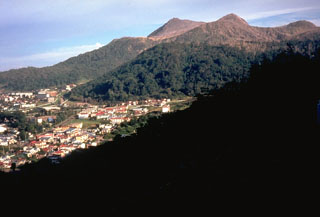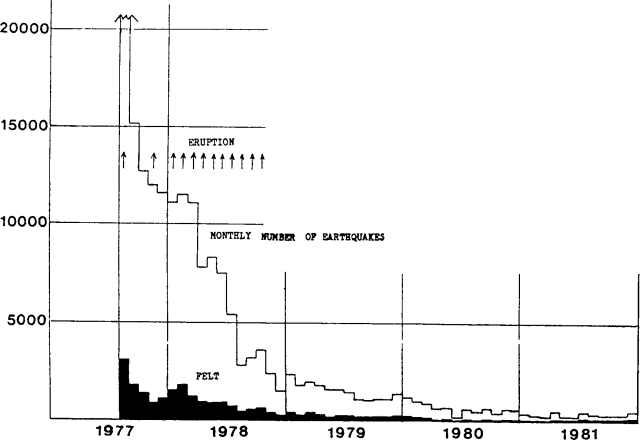Report on Toya (Japan) — March 1982
Scientific Event Alert Network Bulletin, vol. 7, no. 3 (March 1982)
Managing Editor: Lindsay McClelland.
Toya (Japan) Cryptodome growth slows; local seismicity continues
Please cite this report as:
Global Volcanism Program, 1982. Report on Toya (Japan) (McClelland, L., ed.). Scientific Event Alert Network Bulletin, 7:3. Smithsonian Institution. https://doi.org/10.5479/si.GVP.SEAN198203-285030
Toya
Japan
42.544°N, 140.839°E; summit elev. 733 m
All times are local (unless otherwise noted)
"The crustal deformation and local seismicity at Usu continued through 1981. The monthly number of recorded seismic events, having gradually declined since the major 1977 eruption, dropped further to about 308/month in 1981 but remained at about this level through the year (figure 20 and table 4). Gradually weakening steam activity from the craters formed in 1978 has been observed. Around these craters, there have been many fumaroles that vigorously emitted white vapor; highest temperature was 643°C in August 1981. According to the data from the Usu Volcano Observatory (Hokkaido University) the rate of uplift of the Usu-Shinzan cryptodome decreased from about 2/cm per day in 1980 to about 0.8 cm/day in 1981. The northward lateral movement of the N flank continued at a similar rate."
Geological Summary. Usuzan, one of Hokkaido's most well-known volcanoes, is a small stratovolcano located astride the southern topographic rim of the 110,000-year-old Toya caldera. The center of the 10-km-wide, lake-filled caldera contains Nakajima, a group of forested Pleistocene andesitic lava domes. The summit of the basaltic-to-andesitic edifice of Usu is cut by a somma formed about 20-30,000 years ago when collapse of the volcano produced a debris avalanche that reached the sea. Dacitic domes erupted along two NW-SE-trending lines fill and flank the summit caldera. Three of these domes, O-Usu, Ko-Usu and Showashinzan, along with seven crypto-domes, were erupted during historical time. The 1663 eruption of Usu was one of the largest in Hokkaido during historical time. The war-time growth of Showashinzan from 1943-45 was painstakingly documented by the local postmaster, who created the first detailed record of growth of a lava dome.
Information Contacts: I. Yokoyama, Hokkaido Univ.


